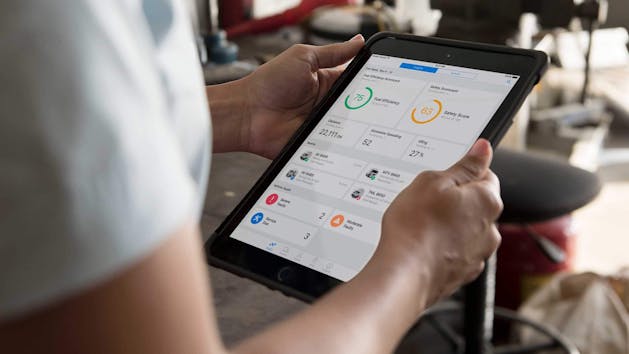Find the right solution for your business with our free Fleet Management Buyer’s Guide.
Maintenance Made Simple for Your Diverse Fleet
Keeping up with regular maintenance schedules can be a full-time job for fleet managers, and the more diverse your fleet, the more challenging it can be.
Whether you’re managing construction vehicles, service trucks, buses, municipal cars or police SUVs, maintaining a variety of vehicles includes wide-ranging requirements and multiple OEM-recommended service schedules. But what are the consequences of falling behind when it comes to maintenance, and how can managers stay on top mixed-fleet maintenance needs—with the help of the right technology?
The costs of mismanaged maintenance
Taking even one vehicle out of service comes at a price to your overall productivity (and by extension, your bottom line), but being short-sighted about routine maintenance or needed repairs can also extract a high price down the road in several key areas.
- Ignoring small issues allows them to escalate, often leading to substantial repair bills that can far exceed the cost of proactive regular maintenance. For example, monitoring oil condition is critical for diesel engines, and timely oil analysis that identifies potential problems earlier rather than later can mean the difference between a $2,500 EGR cooler repair and a $30,000 engine rebuild.1 Tire rotation and air pressure checks also fall into the small-but-critical category; compare $50 for a tire rotation every 7,500 miles with $400 to $1,000 to replace worn tires.2
- Skipping routine maintenance can lead to worn-out brakes, decaying tie rods and engine problems that endanger drivers, workers and anyone else near the vehicle or on the road. Routine maintenance can help reduce these risks.
- When you defer routine maintenance, you can unknowingly allow problems to go unchecked, which can lead to major breakdowns that could bring scheduled jobs to an unplanned, highly-disruptive halt. By proactively scheduling maintenance, you can plan downtime for when it works best for your business needs—and avoid the lost productivity that can result from sidelining a vehicle for days or even weeks for substantial repairs.
- Vehicle lifecycle. Routine maintenance keeps your equipment and vehicles in tip-top shape, not only preventing expensive or dangerous damage, but also helping to extend the working life of your assets.
The smart approach to simplifying maintenance
GPS vehicle tracking and engine diagnostic solutions make it simple and easy to provide your fleet vehicles with the regular maintenance they need to stay in premium condition and deliver the performance your business counts on. Here’s how:
Proactively schedule preventative maintenance. Set up a service schedule for each individual vehicle, based on a calendar, OEM recommendations, engine “on” times or miles driven. You will receive automated reminders when the next service is due through your telematics system. This “set it and forget it” approach eliminates the need to speculate when the last tire rotation was or when the next tune-up should be.
Receive automated alerts about potential trouble. A telematics solution provides automatic alerts to your dashboard and service center when any of your vehicles trigger a fault code signaling an engine issue or transmission malfunction. The faults viewer indicates the description as well as the severity, enabling you to make an informed decision about next steps. You’ll also receive warning alerts on other key indicators including tire pressure, soot level, engine temperature and oil quality, allowing you to take appropriate and timely action to help avoid breakdowns and unnecessarily costly repairs.
Instantly access vital data. With a full end-to-end maintenance management solution, you have on-demand access to the complete repair and maintenance history for every vehicle, helping you improve utilization across your fleet.
Maintain accurate records. Track maintenance spending on tire rotations, oil changes, brake work, critical repairs and other related expenses so you can better predict total costs and make data-driven decisions about when to replace aging or inefficient vehicles.
Streamline DVIRs. Mobile apps make it quick and easy for your drivers to complete and sign off on their daily DVIR, using a smartphone or tablet and electronic forms customized for every type of vehicle, trailer or equipment. Any defects can be sent directly to technicians to note and address.
Monitor driver behavior. GPS tracking not only tells you where your drivers and vehicles are at any given time—it can also flag when drivers speed, brake harshly, idle excessively or drive aggressively. By identifying and improving poor driving habits, you can reduce undue vehicle wear and tear and the associated costs.
Improved maintenance, healthier bottom line
For United Subcontractors Inc. (USI), a feature as simple as the ability to generate daily automated odometer readings through their telematics solution has proven to be invaluable. The company, which serves the construction industry nationwide with a diverse fleet of approximately 1,000 vans, pick-ups, various class box trucks and trailers, previously relied on error-prone manual odometer readings.
Thanks to the now-accurate daily odometer readings, USI estimates that its fleet has gone from 70% maintenance-compliant to 90% compliant. And by completing the right maintenance at the right time, monthly repair expenditures have decreased by 10 to 15 percent.3
The right technology provides a smart way to keep your vehicles serviced and can help you improve fleet performance and vehicle uptime, boost safety, control repair costs and enjoy peace of mind. To learn more about how you can simplify maintenance scheduling and tracking for your diverse fleet with a telematics solution, visit www.verizonconnect.com.
Sources
1 https://www.spectrosci.com/industries/municipal-fleet/
2 https://www.verizonconnect.com/resources/article/how-harsh-driving-affects-bottom-line/
Find out how our platform gives you the visibility you need to get more done.




